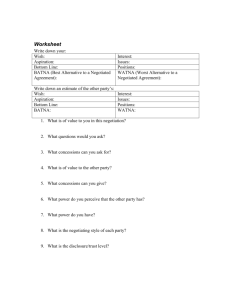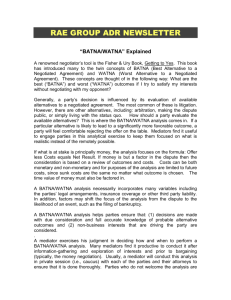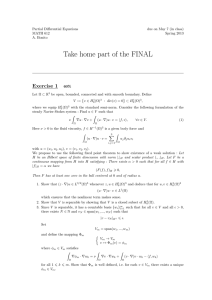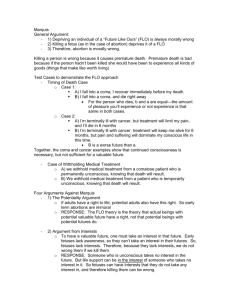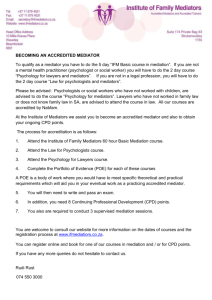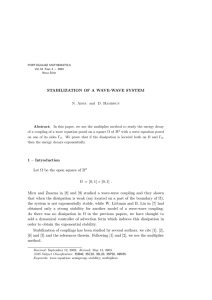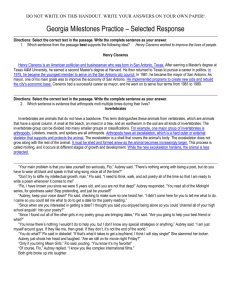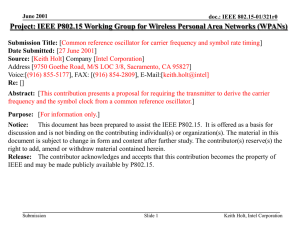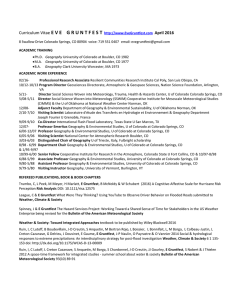risk assessment in commercial mediation
advertisement
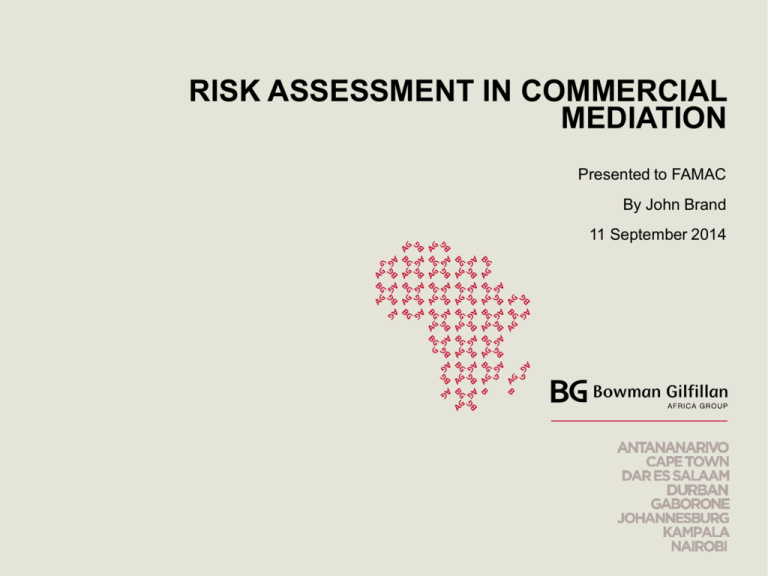
RISK ASSESSMENT IN COMMERCIAL MEDIATION Presented to FAMAC By John Brand 11 September 2014 INTRODUCTION CONTENTS • Why is risk assessment important? • Some risk assessment terms • Why does poor risk assessment lead to deadlock? • What can mediators do to unlock deadlock caused by poor risk assessment? • Do’s and don’ts of mediator risk assessment • Conclusion WHY IS RISK ASSESSMENT IMPORTANT? SCENARIO A • In scenario A, Flo has taken over her father’s taxi business and in the yard is an old 1966 Volkswagen Beetle. She obtained a quote of R500 to remove it to the dump but has not got around to doing so. • Mo, a collector of vintage cars, was passing her yard when he saw the old car. He approached Flo and offered her R1000 for the vehicle. • Flo was delighted to get the offer and accepted it. • If you were Flo what would you have done? WHY IS RISK ASSESSMENT IMPORTANT? SCENARIO B • In scenario B, Flo tells Mo that she would like to think about his offer and she asks him to return on the following day. • Overnight, Flo places an advertisement on the internet “For Sale 1966 Volkswagen – any offers”. She receives on offer of R2000. • Mo returns the following day and asks Flo what her response is to his R1000 offer • Flo responds that the R1000 offer is too low but that she would accept R2500. Mo then raises his offer to R2200 and Flo happily accepts the offer. • If you were Flo what would you have done? WHY IS RISK ASSESSMENT IMPORTANT? SCENARIO C • In scenario C, overnight Flo sends out a second internet advertisement as follows “Wanted 1966 Volkswagen Beetle for vintage collection” and she receives two responses. The first is from a person who offers her an un-reconditioned 1966 Volkswagen Beetle for R8000 and another from a person who offers her one for R10000. • On the following day Mo returns and asks Flo what her response is to his offer of R1000. After some hard bargaining Flo sells the vehicle to Mo for R7000. • What lessons are there for mediators from this negotiation? WHY IS RISK ASSESSMENT IMPORTANT? Each party’s alternative to no agreement: • Sets the lower limit of value that an agreement must provide for each party • It determines whether the parties should negotiate at all • It determines whether the parties should continue to negotiate • It determines whether the parties should agree to proposals or not • It sets the bargaining range SOME RISK ASSESSMENT TERMS • BATNA – Best Alternative to a Negotiated Agreement • WATNA – Worst Alternative to a Negotiated Agreement • RATNA – Realistic Alternative to a Negotiated Agreement • Reservation Point or bottom line is typically similar to a party’s RATNA • Aspiration Point or target is typically better than a party’s BATNA WHY DOES POOR RISK ASSESSMENT LEAD TO DEADLOCK? Because parties: • don’t objectively assess their own BATNA, WATNA and RATNA’s and accordingly have unrealistic expectations • don’t assess what the one party’s perception might be of the other party’s BATNA, WATNA and RATNA • don’t assess what the other parties BATNA, WATNA and RATNA is and accordingly have unrealistic perceptions of such alternatives WHY DOES POOR RISK ASSESSMENT LEAD TO DEADLOCK? Because parties: • don’t seek to strengthen their WATNA and weaken the other party’s BATNA • don’t seek to change the other party’s perception of the first party’s BATNA • don’t seek to change the other party’s perception of its own alternatives WHAT CAN MEDIATORS DO TO UNLOCK DEADLOCK CAUSED BY POOR RISK ASSESSMENT? A mediator needs to: • assess whether one or both of the parties have done an accurate risk assessment • if not, the mediator needs to suggest to the parties that they do one • the mediator may need to suggest to the parties what questions they need to answer WHAT CAN MEDIATORS DO TO UNLOCK DEADLOCK CAUSED BY POOR RISK ASSESSMENT? A mediator needs to: • questions might include costs to trial, costs of trial, prospects of success, chances of recovering costs, consequences for reputation, time and stress, legal merits • the mediator may sensitively question and test the parties’ risk analysis • the mediator may, with permission, exchange the parties’ risk assessments with each other and help them adjust their perceptions of their own and the other party’s alternatives DO’S AND DON’TS OF MEDIATOR RISK ASSESSMENT • At the preparation stage tell the parties that part of your role is to test their positions and ask lawyers to bring to the mediation details on costs to mediation, costs to trial, assessment of success at trial, etc • Conduct risk assessment in side meetings rather than in joint sessions • Be aware that rapport may come under pressure when you reality test, so work hard to maintain rapport • Don’t do it too early in the mediation – ‘keep your powder dry’ • Do it gently and tentatively DO’S AND DON’TS OF MEDIATOR RISK ASSESSMENT • Try not to be evaluative but rather be inquisitive • Remind the parties that reality testing is part of your role and that you are doing it in both rooms • Try to bring parties to their senses by questions rather than to their knees by judgment • Consider using the flipchart to compare the offer with costs going forward • Leave parties with lawyers to reflect on your challenges before asking for a further proposal CONCLUSION

